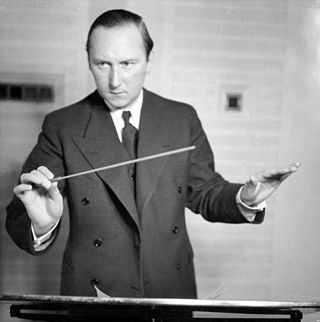Related Research Articles

The Brandenburg Concertos by Johann Sebastian Bach, are a collection of six instrumental works presented by Bach to Christian Ludwig, Margrave of Brandenburg-Schwedt, in 1721. The original French title is Six Concerts à plusieurs instruments, meaning "Six Concertos for several instruments". Some of them feature several solo instruments in combination. They are widely regarded as some of the best orchestral compositions of the Baroque era.

Kurt Magnus Atterberg was a Swedish composer and engineer. He is best known for his symphonies, operas, and ballets.
Vittorio Rieti was a Jewish-Italian-American composer. Born in Alexandria, Egypt, Rieti moved to Milan to study economics. He subsequently studied in Rome under Respighi and Casella, and lived there until 1940.
Felix Mendelssohn's Sextet in D major, Op. 110, MWV Q 16, for piano, violin, two violas, cello, and double bass was composed in April–May 1824, when Mendelssohn was only 15, the same time he was working on a comic opera Die Hochzeit des Camacho. Its composition took place between the Viola Sonata and the Piano Quartet No. 3. It also preceded the famous Octet, Op. 20 by about a year. 1824 is also the probable year of the composition of the Clarinet Sonata. Like the latter, the Sextet was not published during the composer's lifetime. Its first edition was issued in 1868 as a part of a complete collection of Mendelssohn's works. Hence the misleading high opus number.
Jean François Toussaint Rogister was a Belgian virtuoso violist, teacher and composer.
Will Gay Bottje ) was an American composer known for his contributions to electronic music.
Claude Debussy's Six sonatas for various instruments, composed by Claude Debussy, French musician was a projected cycle of sonatas that was interrupted by the composer's death in 1918, after he had composed only half of the projected sonatas. He left behind his sonatas for cello and piano (1915), flute, viola and harp (1915), and violin and piano (1916–1917).
The Piano Quartet No. 2 in G major, Op. 26 by Henrique Oswald was composed in the second half of 1898. It is scored for piano, violin, viola and cello. The approximate duration is 25–30 minutes.

The Symphony No. 2, Op. 14, is a three-movement orchestral composition written from 1938 to 1939 by the Swedish composer Dag Wirén. Despite its numbering, the Second Symphony represents Wirén's first contribution to the form as a professional. Swedish conductor Sixten Eckerberg premiered the new symphony with the Gothenburg Symphony Orchestra in Gothenburg on 13 October 1940. Although the public received the premiere positively, the critics cautioned that the new work was mildly derivative of Carl Nielsen. At 30 minutes, the Second is the longest of Wirén's four essays in the genre, as well as, stylistically, the most late-Romantic and pastoral of the set.

The Symphony No. 3, Op. 20, is a three-movement orchestral composition written from 1943 to 1944 by the Swedish composer Dag Wirén. Despite its numbering, the Third Symphony represents Wirén's second contribution to the form as a professional, arriving five years after its predecessor, the Symphony No. 2. Swedish conductor Sixten Eckerberg premiered the new symphony with the Gothenburg Symphony Orchestra in Gothenburg on 28 September 1944.
This article lists notable compositions within the viola repertoire. The list includes works in which the viola is a featured instrument. The list is ordered by composer surname.

The Pastoral Suite, Op. 19, is a three-movement suite for orchestra written in 1938 by Swedish composer Lars-Erik Larsson. The suite remains not only one of Larsson's most celebrated compositions, but also one of the most frequently performed pieces of Swedish art music. In particular, the Romance (No. 2) is often performed and recorded as a stand-alone concert piece.

The Violin Concerto, Op. 54, is a three-movement concertante composition for violin and orchestra written in 1952 by the Swedish composer Lars-Erik Larsson. The piece premiered over Swedish Radio on 11 January 1953 in Stockholm, Sweden, with Sten Frykberg conducting the Swedish Radio Orchestra. The soloist was the Hungarian violinist André Gertler, its dedicatee.

The Violin Concerto, Op. 23, is a three-movement concertante composition for violin and orchestra written from 1945 to 1946 by the Swedish composer Dag Wirén. The piece premiered on 10 April 1947 in Gothenburg, Sweden, with Clarence Raybould conducting the Gothenburg Orchestral Society; the soloist was the Swedish violinist Otto Kyndel. The Violin Concerto is a rare example of Wirén—the idiom of whom was primarily neo-classical—embracing a "full-blooded" neo-romantic style; it is, with its "greater depth of expression, ... in the spirit of" Jean Sibelius. In a 1979 radio interview, Wirén characterized the Violin Concerto as one of the best pieces he had composed
References
- 1 2 3 Stig Jacobsson (adapted by Keith Anderson). Booklet notes to Marco Polo 8.223404
- 1 2 3 Stig Jacobsson . Booklet notes to Marco Polo 8.223405
- ↑ The dates given here are those of CD issues, not of the recordings.